Psychology Assignment: Decision-Making, Observational Learning Report
VerifiedAdded on 2023/04/23
|11
|2625
|499
Report
AI Summary
This psychology report examines the crucial concepts of decision-making and observational learning, emphasizing their significance for social workers. It begins by defining decision-making and exploring various models such as the Single-Feature model and the Additive Feature model, alongside strategies like availability and representative heuristics, providing real-world examples to illustrate their application. The report then transitions to observational learning, detailing Bandura's social learning theory and its four key stages: attention, retention, reproduction, and motivation. The report highlights how social workers can use these theories to understand and address clients' challenges, including those related to domestic violence and behavioral issues. By understanding these psychological principles, social workers can develop more effective counseling and care plans, ultimately helping clients improve their mental stability and quality of life. The report concludes by referencing several academic sources to support the discussed theories and concepts.
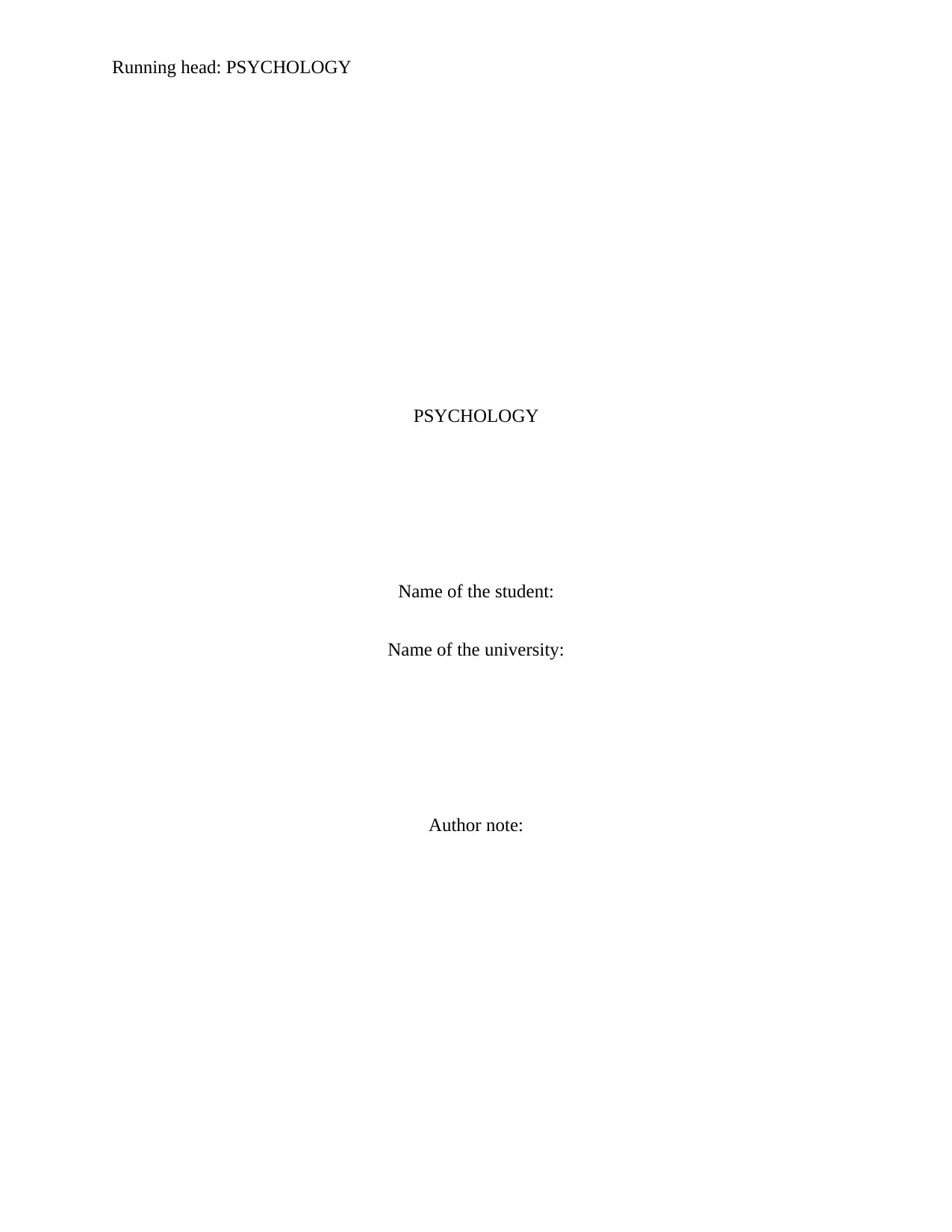
Running head: PSYCHOLOGY
PSYCHOLOGY
Name of the student:
Name of the university:
Author note:
PSYCHOLOGY
Name of the student:
Name of the university:
Author note:
Secure Best Marks with AI Grader
Need help grading? Try our AI Grader for instant feedback on your assignments.
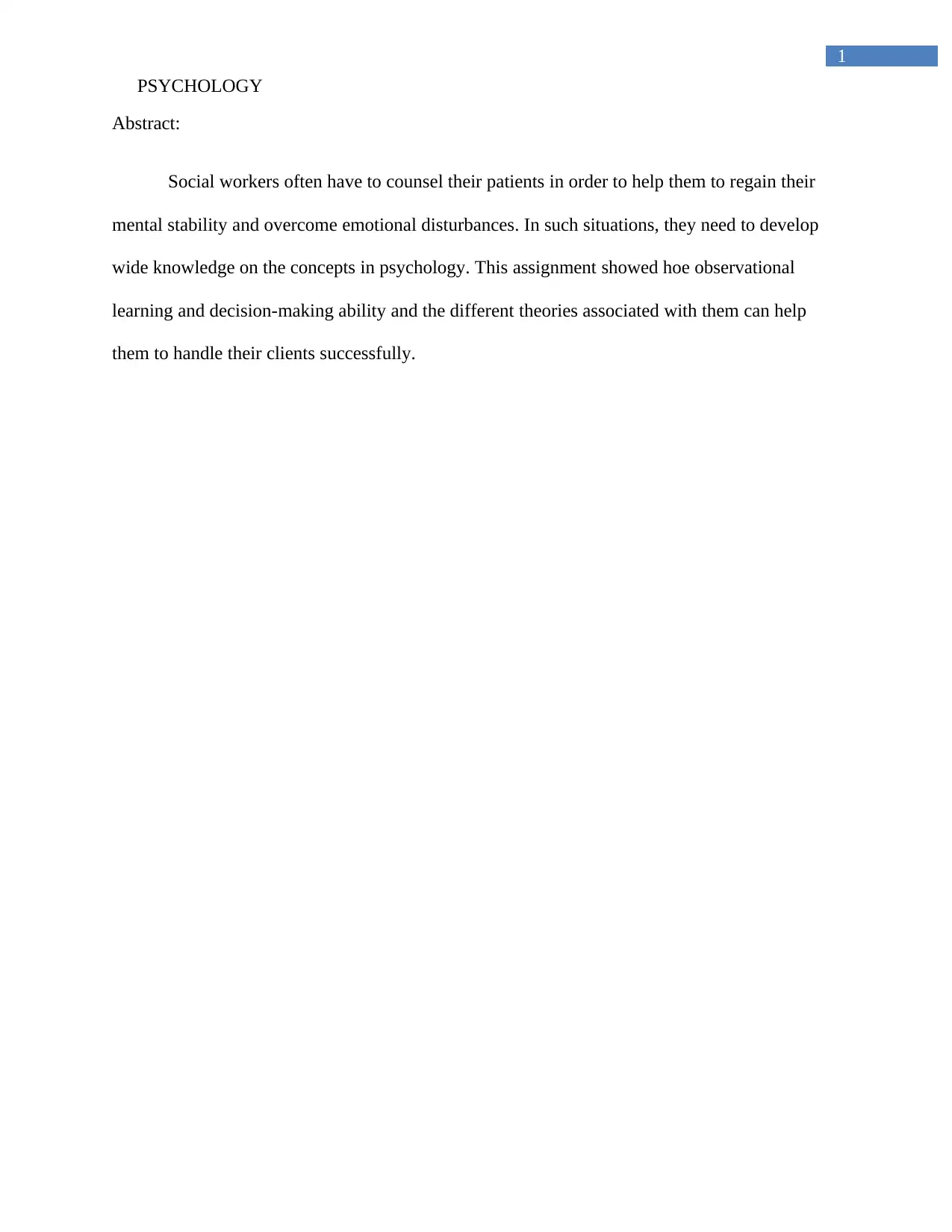
1
PSYCHOLOGY
Abstract:
Social workers often have to counsel their patients in order to help them to regain their
mental stability and overcome emotional disturbances. In such situations, they need to develop
wide knowledge on the concepts in psychology. This assignment showed hoe observational
learning and decision-making ability and the different theories associated with them can help
them to handle their clients successfully.
PSYCHOLOGY
Abstract:
Social workers often have to counsel their patients in order to help them to regain their
mental stability and overcome emotional disturbances. In such situations, they need to develop
wide knowledge on the concepts in psychology. This assignment showed hoe observational
learning and decision-making ability and the different theories associated with them can help
them to handle their clients successfully.
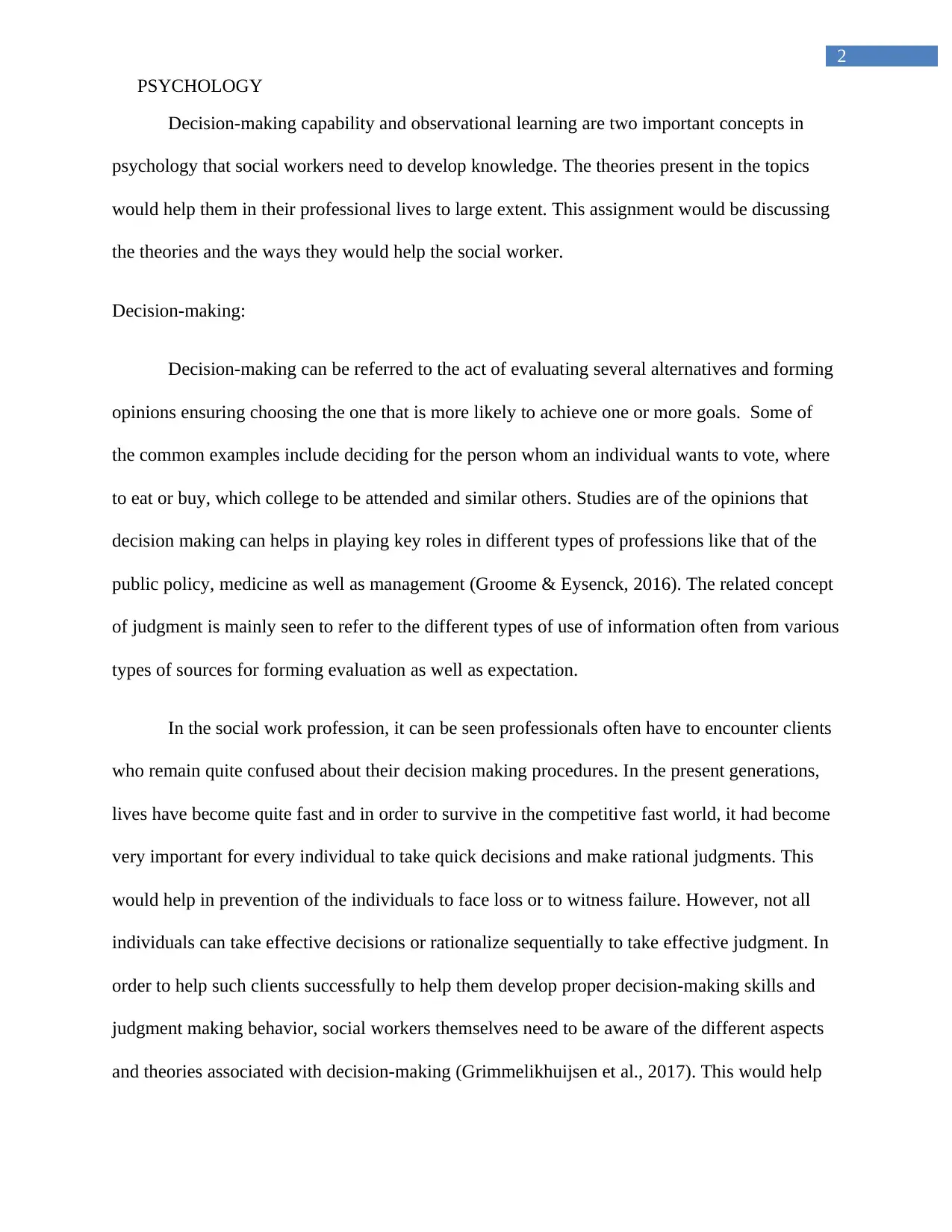
2
PSYCHOLOGY
Decision-making capability and observational learning are two important concepts in
psychology that social workers need to develop knowledge. The theories present in the topics
would help them in their professional lives to large extent. This assignment would be discussing
the theories and the ways they would help the social worker.
Decision-making:
Decision-making can be referred to the act of evaluating several alternatives and forming
opinions ensuring choosing the one that is more likely to achieve one or more goals. Some of
the common examples include deciding for the person whom an individual wants to vote, where
to eat or buy, which college to be attended and similar others. Studies are of the opinions that
decision making can helps in playing key roles in different types of professions like that of the
public policy, medicine as well as management (Groome & Eysenck, 2016). The related concept
of judgment is mainly seen to refer to the different types of use of information often from various
types of sources for forming evaluation as well as expectation.
In the social work profession, it can be seen professionals often have to encounter clients
who remain quite confused about their decision making procedures. In the present generations,
lives have become quite fast and in order to survive in the competitive fast world, it had become
very important for every individual to take quick decisions and make rational judgments. This
would help in prevention of the individuals to face loss or to witness failure. However, not all
individuals can take effective decisions or rationalize sequentially to take effective judgment. In
order to help such clients successfully to help them develop proper decision-making skills and
judgment making behavior, social workers themselves need to be aware of the different aspects
and theories associated with decision-making (Grimmelikhuijsen et al., 2017). This would help
PSYCHOLOGY
Decision-making capability and observational learning are two important concepts in
psychology that social workers need to develop knowledge. The theories present in the topics
would help them in their professional lives to large extent. This assignment would be discussing
the theories and the ways they would help the social worker.
Decision-making:
Decision-making can be referred to the act of evaluating several alternatives and forming
opinions ensuring choosing the one that is more likely to achieve one or more goals. Some of
the common examples include deciding for the person whom an individual wants to vote, where
to eat or buy, which college to be attended and similar others. Studies are of the opinions that
decision making can helps in playing key roles in different types of professions like that of the
public policy, medicine as well as management (Groome & Eysenck, 2016). The related concept
of judgment is mainly seen to refer to the different types of use of information often from various
types of sources for forming evaluation as well as expectation.
In the social work profession, it can be seen professionals often have to encounter clients
who remain quite confused about their decision making procedures. In the present generations,
lives have become quite fast and in order to survive in the competitive fast world, it had become
very important for every individual to take quick decisions and make rational judgments. This
would help in prevention of the individuals to face loss or to witness failure. However, not all
individuals can take effective decisions or rationalize sequentially to take effective judgment. In
order to help such clients successfully to help them develop proper decision-making skills and
judgment making behavior, social workers themselves need to be aware of the different aspects
and theories associated with decision-making (Grimmelikhuijsen et al., 2017). This would help
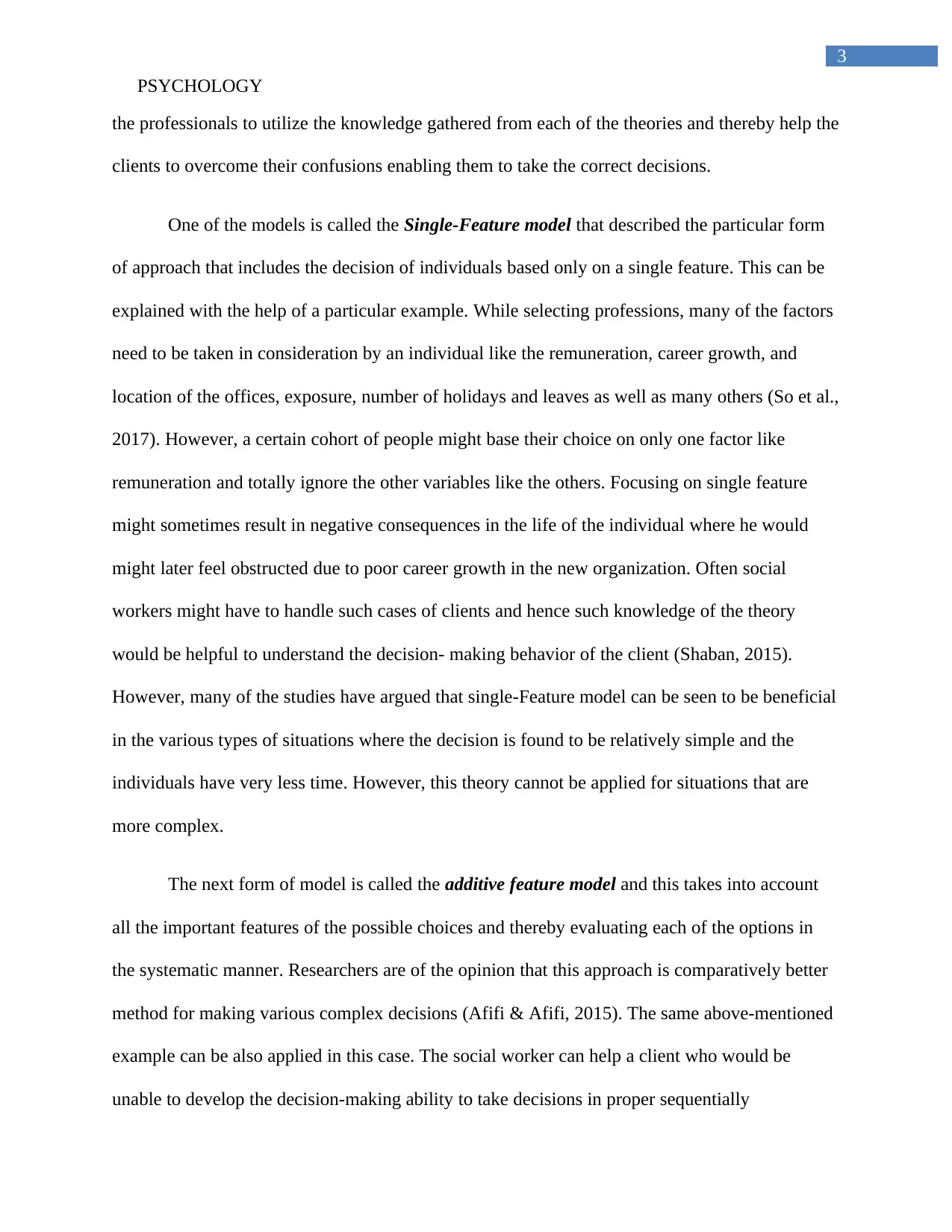
3
PSYCHOLOGY
the professionals to utilize the knowledge gathered from each of the theories and thereby help the
clients to overcome their confusions enabling them to take the correct decisions.
One of the models is called the Single-Feature model that described the particular form
of approach that includes the decision of individuals based only on a single feature. This can be
explained with the help of a particular example. While selecting professions, many of the factors
need to be taken in consideration by an individual like the remuneration, career growth, and
location of the offices, exposure, number of holidays and leaves as well as many others (So et al.,
2017). However, a certain cohort of people might base their choice on only one factor like
remuneration and totally ignore the other variables like the others. Focusing on single feature
might sometimes result in negative consequences in the life of the individual where he would
might later feel obstructed due to poor career growth in the new organization. Often social
workers might have to handle such cases of clients and hence such knowledge of the theory
would be helpful to understand the decision- making behavior of the client (Shaban, 2015).
However, many of the studies have argued that single-Feature model can be seen to be beneficial
in the various types of situations where the decision is found to be relatively simple and the
individuals have very less time. However, this theory cannot be applied for situations that are
more complex.
The next form of model is called the additive feature model and this takes into account
all the important features of the possible choices and thereby evaluating each of the options in
the systematic manner. Researchers are of the opinion that this approach is comparatively better
method for making various complex decisions (Afifi & Afifi, 2015). The same above-mentioned
example can be also applied in this case. The social worker can help a client who would be
unable to develop the decision-making ability to take decisions in proper sequentially
PSYCHOLOGY
the professionals to utilize the knowledge gathered from each of the theories and thereby help the
clients to overcome their confusions enabling them to take the correct decisions.
One of the models is called the Single-Feature model that described the particular form
of approach that includes the decision of individuals based only on a single feature. This can be
explained with the help of a particular example. While selecting professions, many of the factors
need to be taken in consideration by an individual like the remuneration, career growth, and
location of the offices, exposure, number of holidays and leaves as well as many others (So et al.,
2017). However, a certain cohort of people might base their choice on only one factor like
remuneration and totally ignore the other variables like the others. Focusing on single feature
might sometimes result in negative consequences in the life of the individual where he would
might later feel obstructed due to poor career growth in the new organization. Often social
workers might have to handle such cases of clients and hence such knowledge of the theory
would be helpful to understand the decision- making behavior of the client (Shaban, 2015).
However, many of the studies have argued that single-Feature model can be seen to be beneficial
in the various types of situations where the decision is found to be relatively simple and the
individuals have very less time. However, this theory cannot be applied for situations that are
more complex.
The next form of model is called the additive feature model and this takes into account
all the important features of the possible choices and thereby evaluating each of the options in
the systematic manner. Researchers are of the opinion that this approach is comparatively better
method for making various complex decisions (Afifi & Afifi, 2015). The same above-mentioned
example can be also applied in this case. The social worker can help a client who would be
unable to develop the decision-making ability to take decisions in proper sequentially
Secure Best Marks with AI Grader
Need help grading? Try our AI Grader for instant feedback on your assignments.
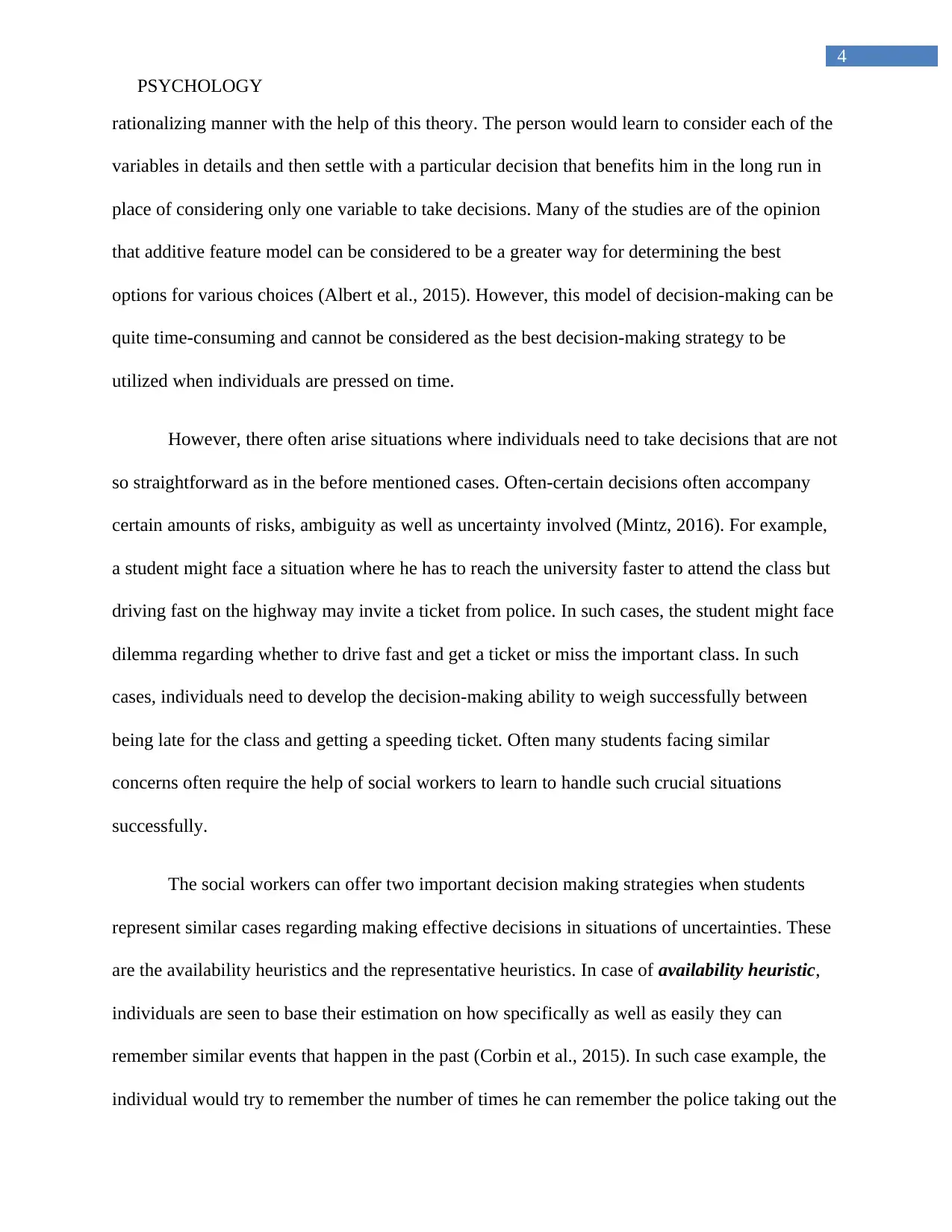
4
PSYCHOLOGY
rationalizing manner with the help of this theory. The person would learn to consider each of the
variables in details and then settle with a particular decision that benefits him in the long run in
place of considering only one variable to take decisions. Many of the studies are of the opinion
that additive feature model can be considered to be a greater way for determining the best
options for various choices (Albert et al., 2015). However, this model of decision-making can be
quite time-consuming and cannot be considered as the best decision-making strategy to be
utilized when individuals are pressed on time.
However, there often arise situations where individuals need to take decisions that are not
so straightforward as in the before mentioned cases. Often-certain decisions often accompany
certain amounts of risks, ambiguity as well as uncertainty involved (Mintz, 2016). For example,
a student might face a situation where he has to reach the university faster to attend the class but
driving fast on the highway may invite a ticket from police. In such cases, the student might face
dilemma regarding whether to drive fast and get a ticket or miss the important class. In such
cases, individuals need to develop the decision-making ability to weigh successfully between
being late for the class and getting a speeding ticket. Often many students facing similar
concerns often require the help of social workers to learn to handle such crucial situations
successfully.
The social workers can offer two important decision making strategies when students
represent similar cases regarding making effective decisions in situations of uncertainties. These
are the availability heuristics and the representative heuristics. In case of availability heuristic,
individuals are seen to base their estimation on how specifically as well as easily they can
remember similar events that happen in the past (Corbin et al., 2015). In such case example, the
individual would try to remember the number of times he can remember the police taking out the
PSYCHOLOGY
rationalizing manner with the help of this theory. The person would learn to consider each of the
variables in details and then settle with a particular decision that benefits him in the long run in
place of considering only one variable to take decisions. Many of the studies are of the opinion
that additive feature model can be considered to be a greater way for determining the best
options for various choices (Albert et al., 2015). However, this model of decision-making can be
quite time-consuming and cannot be considered as the best decision-making strategy to be
utilized when individuals are pressed on time.
However, there often arise situations where individuals need to take decisions that are not
so straightforward as in the before mentioned cases. Often-certain decisions often accompany
certain amounts of risks, ambiguity as well as uncertainty involved (Mintz, 2016). For example,
a student might face a situation where he has to reach the university faster to attend the class but
driving fast on the highway may invite a ticket from police. In such cases, the student might face
dilemma regarding whether to drive fast and get a ticket or miss the important class. In such
cases, individuals need to develop the decision-making ability to weigh successfully between
being late for the class and getting a speeding ticket. Often many students facing similar
concerns often require the help of social workers to learn to handle such crucial situations
successfully.
The social workers can offer two important decision making strategies when students
represent similar cases regarding making effective decisions in situations of uncertainties. These
are the availability heuristics and the representative heuristics. In case of availability heuristic,
individuals are seen to base their estimation on how specifically as well as easily they can
remember similar events that happen in the past (Corbin et al., 2015). In such case example, the
individual would try to remember the number of times he can remember the police taking out the
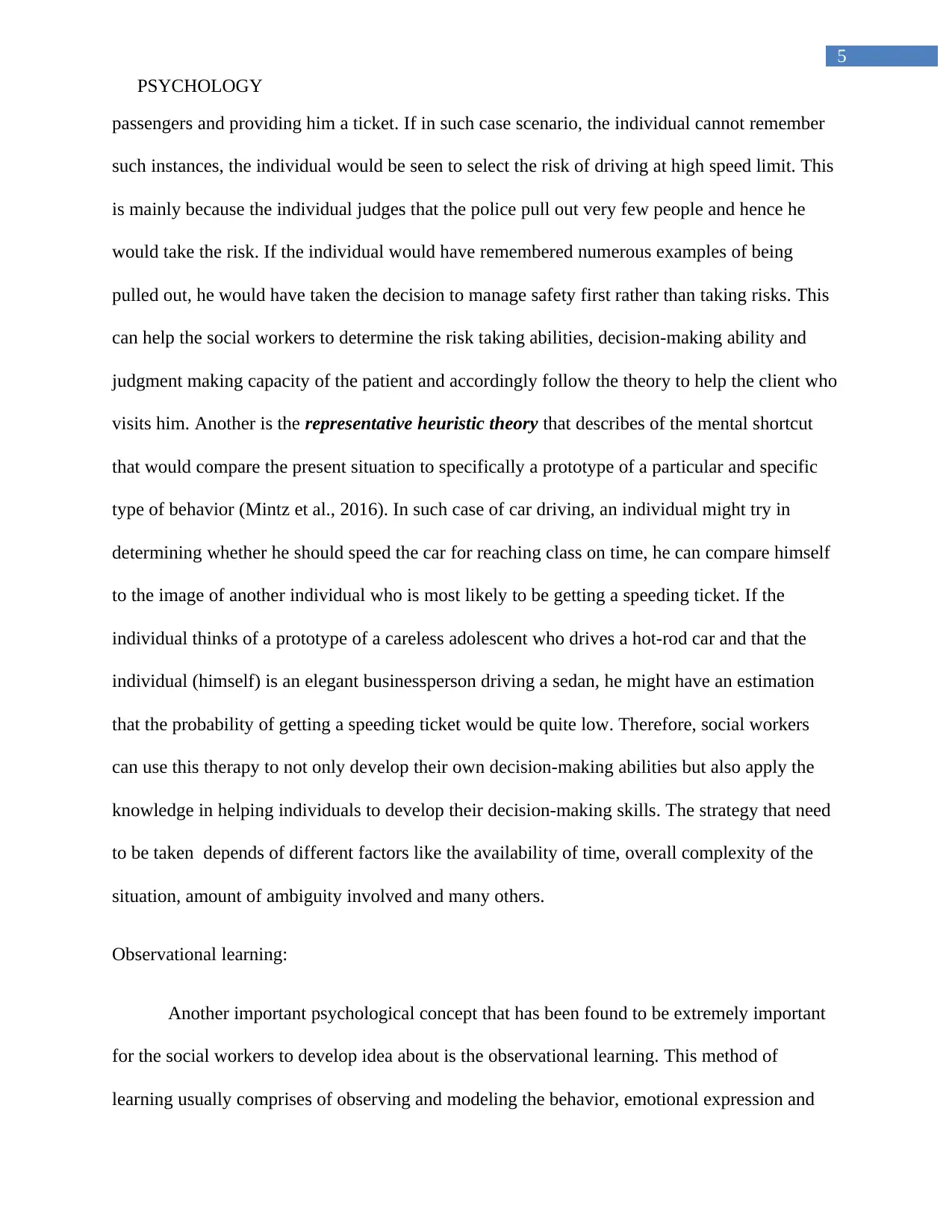
5
PSYCHOLOGY
passengers and providing him a ticket. If in such case scenario, the individual cannot remember
such instances, the individual would be seen to select the risk of driving at high speed limit. This
is mainly because the individual judges that the police pull out very few people and hence he
would take the risk. If the individual would have remembered numerous examples of being
pulled out, he would have taken the decision to manage safety first rather than taking risks. This
can help the social workers to determine the risk taking abilities, decision-making ability and
judgment making capacity of the patient and accordingly follow the theory to help the client who
visits him. Another is the representative heuristic theory that describes of the mental shortcut
that would compare the present situation to specifically a prototype of a particular and specific
type of behavior (Mintz et al., 2016). In such case of car driving, an individual might try in
determining whether he should speed the car for reaching class on time, he can compare himself
to the image of another individual who is most likely to be getting a speeding ticket. If the
individual thinks of a prototype of a careless adolescent who drives a hot-rod car and that the
individual (himself) is an elegant businessperson driving a sedan, he might have an estimation
that the probability of getting a speeding ticket would be quite low. Therefore, social workers
can use this therapy to not only develop their own decision-making abilities but also apply the
knowledge in helping individuals to develop their decision-making skills. The strategy that need
to be taken depends of different factors like the availability of time, overall complexity of the
situation, amount of ambiguity involved and many others.
Observational learning:
Another important psychological concept that has been found to be extremely important
for the social workers to develop idea about is the observational learning. This method of
learning usually comprises of observing and modeling the behavior, emotional expression and
PSYCHOLOGY
passengers and providing him a ticket. If in such case scenario, the individual cannot remember
such instances, the individual would be seen to select the risk of driving at high speed limit. This
is mainly because the individual judges that the police pull out very few people and hence he
would take the risk. If the individual would have remembered numerous examples of being
pulled out, he would have taken the decision to manage safety first rather than taking risks. This
can help the social workers to determine the risk taking abilities, decision-making ability and
judgment making capacity of the patient and accordingly follow the theory to help the client who
visits him. Another is the representative heuristic theory that describes of the mental shortcut
that would compare the present situation to specifically a prototype of a particular and specific
type of behavior (Mintz et al., 2016). In such case of car driving, an individual might try in
determining whether he should speed the car for reaching class on time, he can compare himself
to the image of another individual who is most likely to be getting a speeding ticket. If the
individual thinks of a prototype of a careless adolescent who drives a hot-rod car and that the
individual (himself) is an elegant businessperson driving a sedan, he might have an estimation
that the probability of getting a speeding ticket would be quite low. Therefore, social workers
can use this therapy to not only develop their own decision-making abilities but also apply the
knowledge in helping individuals to develop their decision-making skills. The strategy that need
to be taken depends of different factors like the availability of time, overall complexity of the
situation, amount of ambiguity involved and many others.
Observational learning:
Another important psychological concept that has been found to be extremely important
for the social workers to develop idea about is the observational learning. This method of
learning usually comprises of observing and modeling the behavior, emotional expression and
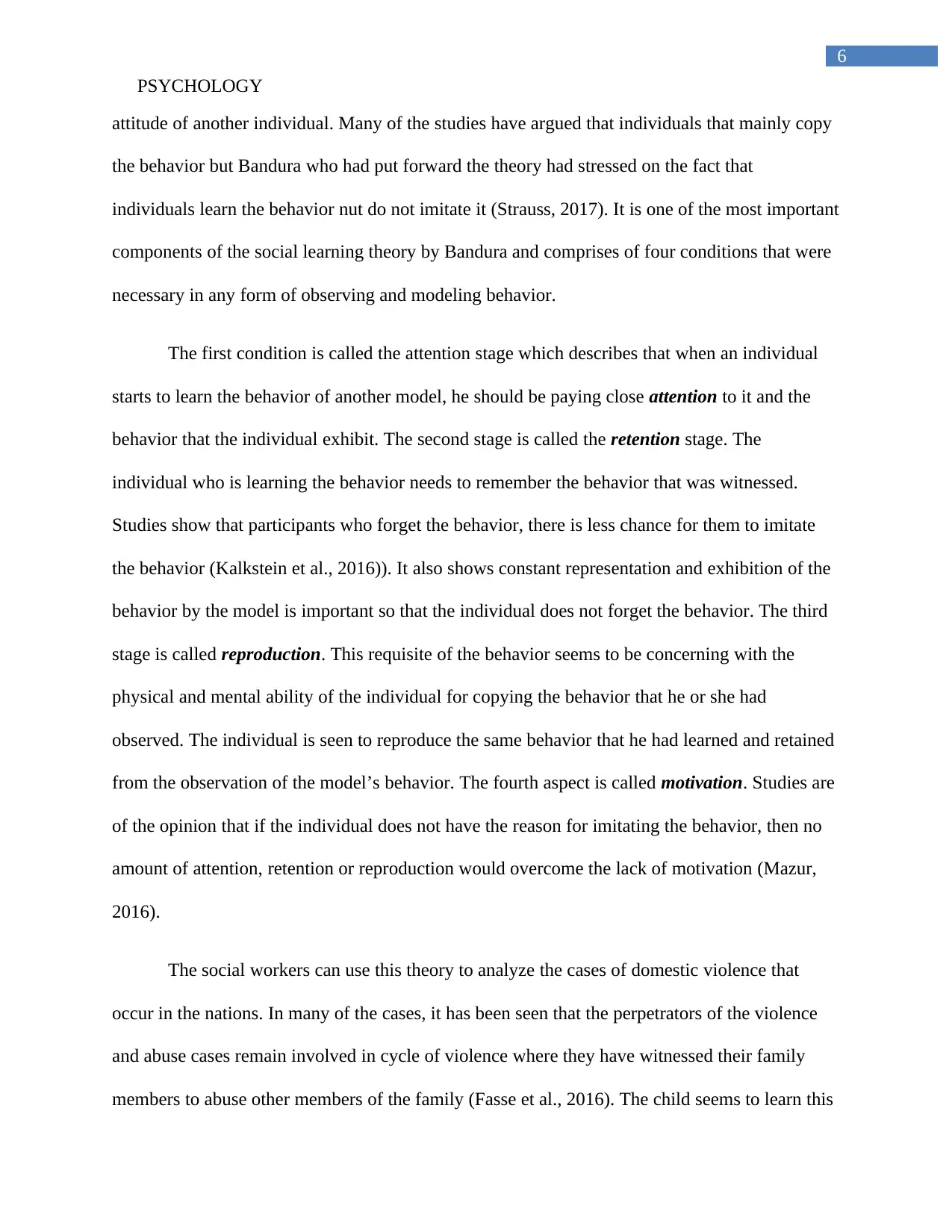
6
PSYCHOLOGY
attitude of another individual. Many of the studies have argued that individuals that mainly copy
the behavior but Bandura who had put forward the theory had stressed on the fact that
individuals learn the behavior nut do not imitate it (Strauss, 2017). It is one of the most important
components of the social learning theory by Bandura and comprises of four conditions that were
necessary in any form of observing and modeling behavior.
The first condition is called the attention stage which describes that when an individual
starts to learn the behavior of another model, he should be paying close attention to it and the
behavior that the individual exhibit. The second stage is called the retention stage. The
individual who is learning the behavior needs to remember the behavior that was witnessed.
Studies show that participants who forget the behavior, there is less chance for them to imitate
the behavior (Kalkstein et al., 2016)). It also shows constant representation and exhibition of the
behavior by the model is important so that the individual does not forget the behavior. The third
stage is called reproduction. This requisite of the behavior seems to be concerning with the
physical and mental ability of the individual for copying the behavior that he or she had
observed. The individual is seen to reproduce the same behavior that he had learned and retained
from the observation of the model’s behavior. The fourth aspect is called motivation. Studies are
of the opinion that if the individual does not have the reason for imitating the behavior, then no
amount of attention, retention or reproduction would overcome the lack of motivation (Mazur,
2016).
The social workers can use this theory to analyze the cases of domestic violence that
occur in the nations. In many of the cases, it has been seen that the perpetrators of the violence
and abuse cases remain involved in cycle of violence where they have witnessed their family
members to abuse other members of the family (Fasse et al., 2016). The child seems to learn this
PSYCHOLOGY
attitude of another individual. Many of the studies have argued that individuals that mainly copy
the behavior but Bandura who had put forward the theory had stressed on the fact that
individuals learn the behavior nut do not imitate it (Strauss, 2017). It is one of the most important
components of the social learning theory by Bandura and comprises of four conditions that were
necessary in any form of observing and modeling behavior.
The first condition is called the attention stage which describes that when an individual
starts to learn the behavior of another model, he should be paying close attention to it and the
behavior that the individual exhibit. The second stage is called the retention stage. The
individual who is learning the behavior needs to remember the behavior that was witnessed.
Studies show that participants who forget the behavior, there is less chance for them to imitate
the behavior (Kalkstein et al., 2016)). It also shows constant representation and exhibition of the
behavior by the model is important so that the individual does not forget the behavior. The third
stage is called reproduction. This requisite of the behavior seems to be concerning with the
physical and mental ability of the individual for copying the behavior that he or she had
observed. The individual is seen to reproduce the same behavior that he had learned and retained
from the observation of the model’s behavior. The fourth aspect is called motivation. Studies are
of the opinion that if the individual does not have the reason for imitating the behavior, then no
amount of attention, retention or reproduction would overcome the lack of motivation (Mazur,
2016).
The social workers can use this theory to analyze the cases of domestic violence that
occur in the nations. In many of the cases, it has been seen that the perpetrators of the violence
and abuse cases remain involved in cycle of violence where they have witnessed their family
members to abuse other members of the family (Fasse et al., 2016). The child seems to learn this
Paraphrase This Document
Need a fresh take? Get an instant paraphrase of this document with our AI Paraphraser
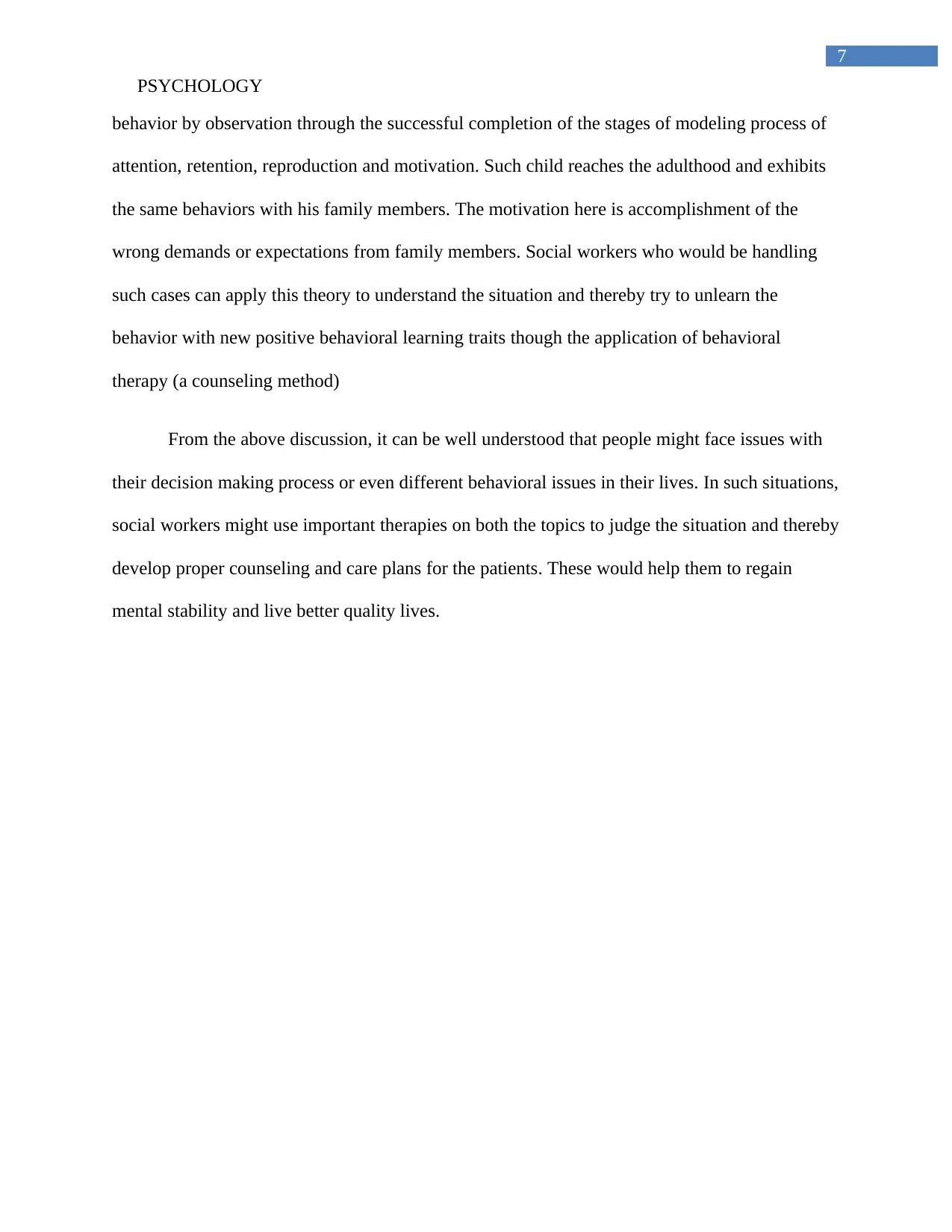
7
PSYCHOLOGY
behavior by observation through the successful completion of the stages of modeling process of
attention, retention, reproduction and motivation. Such child reaches the adulthood and exhibits
the same behaviors with his family members. The motivation here is accomplishment of the
wrong demands or expectations from family members. Social workers who would be handling
such cases can apply this theory to understand the situation and thereby try to unlearn the
behavior with new positive behavioral learning traits though the application of behavioral
therapy (a counseling method)
From the above discussion, it can be well understood that people might face issues with
their decision making process or even different behavioral issues in their lives. In such situations,
social workers might use important therapies on both the topics to judge the situation and thereby
develop proper counseling and care plans for the patients. These would help them to regain
mental stability and live better quality lives.
PSYCHOLOGY
behavior by observation through the successful completion of the stages of modeling process of
attention, retention, reproduction and motivation. Such child reaches the adulthood and exhibits
the same behaviors with his family members. The motivation here is accomplishment of the
wrong demands or expectations from family members. Social workers who would be handling
such cases can apply this theory to understand the situation and thereby try to unlearn the
behavior with new positive behavioral learning traits though the application of behavioral
therapy (a counseling method)
From the above discussion, it can be well understood that people might face issues with
their decision making process or even different behavioral issues in their lives. In such situations,
social workers might use important therapies on both the topics to judge the situation and thereby
develop proper counseling and care plans for the patients. These would help them to regain
mental stability and live better quality lives.
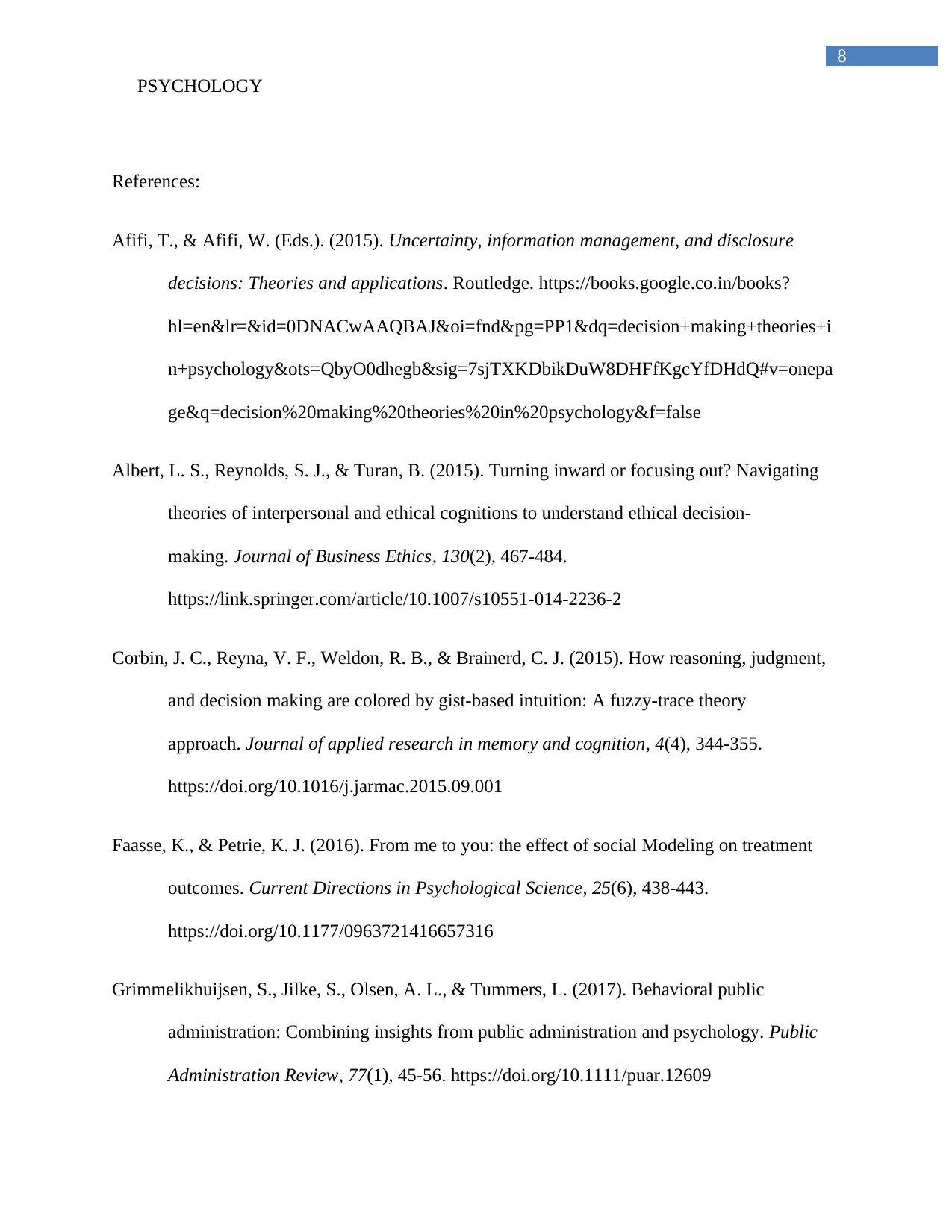
8
PSYCHOLOGY
References:
Afifi, T., & Afifi, W. (Eds.). (2015). Uncertainty, information management, and disclosure
decisions: Theories and applications. Routledge. https://books.google.co.in/books?
hl=en&lr=&id=0DNACwAAQBAJ&oi=fnd&pg=PP1&dq=decision+making+theories+i
n+psychology&ots=QbyO0dhegb&sig=7sjTXKDbikDuW8DHFfKgcYfDHdQ#v=onepa
ge&q=decision%20making%20theories%20in%20psychology&f=false
Albert, L. S., Reynolds, S. J., & Turan, B. (2015). Turning inward or focusing out? Navigating
theories of interpersonal and ethical cognitions to understand ethical decision-
making. Journal of Business Ethics, 130(2), 467-484.
https://link.springer.com/article/10.1007/s10551-014-2236-2
Corbin, J. C., Reyna, V. F., Weldon, R. B., & Brainerd, C. J. (2015). How reasoning, judgment,
and decision making are colored by gist-based intuition: A fuzzy-trace theory
approach. Journal of applied research in memory and cognition, 4(4), 344-355.
https://doi.org/10.1016/j.jarmac.2015.09.001
Faasse, K., & Petrie, K. J. (2016). From me to you: the effect of social Modeling on treatment
outcomes. Current Directions in Psychological Science, 25(6), 438-443.
https://doi.org/10.1177/0963721416657316
Grimmelikhuijsen, S., Jilke, S., Olsen, A. L., & Tummers, L. (2017). Behavioral public
administration: Combining insights from public administration and psychology. Public
Administration Review, 77(1), 45-56. https://doi.org/10.1111/puar.12609
PSYCHOLOGY
References:
Afifi, T., & Afifi, W. (Eds.). (2015). Uncertainty, information management, and disclosure
decisions: Theories and applications. Routledge. https://books.google.co.in/books?
hl=en&lr=&id=0DNACwAAQBAJ&oi=fnd&pg=PP1&dq=decision+making+theories+i
n+psychology&ots=QbyO0dhegb&sig=7sjTXKDbikDuW8DHFfKgcYfDHdQ#v=onepa
ge&q=decision%20making%20theories%20in%20psychology&f=false
Albert, L. S., Reynolds, S. J., & Turan, B. (2015). Turning inward or focusing out? Navigating
theories of interpersonal and ethical cognitions to understand ethical decision-
making. Journal of Business Ethics, 130(2), 467-484.
https://link.springer.com/article/10.1007/s10551-014-2236-2
Corbin, J. C., Reyna, V. F., Weldon, R. B., & Brainerd, C. J. (2015). How reasoning, judgment,
and decision making are colored by gist-based intuition: A fuzzy-trace theory
approach. Journal of applied research in memory and cognition, 4(4), 344-355.
https://doi.org/10.1016/j.jarmac.2015.09.001
Faasse, K., & Petrie, K. J. (2016). From me to you: the effect of social Modeling on treatment
outcomes. Current Directions in Psychological Science, 25(6), 438-443.
https://doi.org/10.1177/0963721416657316
Grimmelikhuijsen, S., Jilke, S., Olsen, A. L., & Tummers, L. (2017). Behavioral public
administration: Combining insights from public administration and psychology. Public
Administration Review, 77(1), 45-56. https://doi.org/10.1111/puar.12609
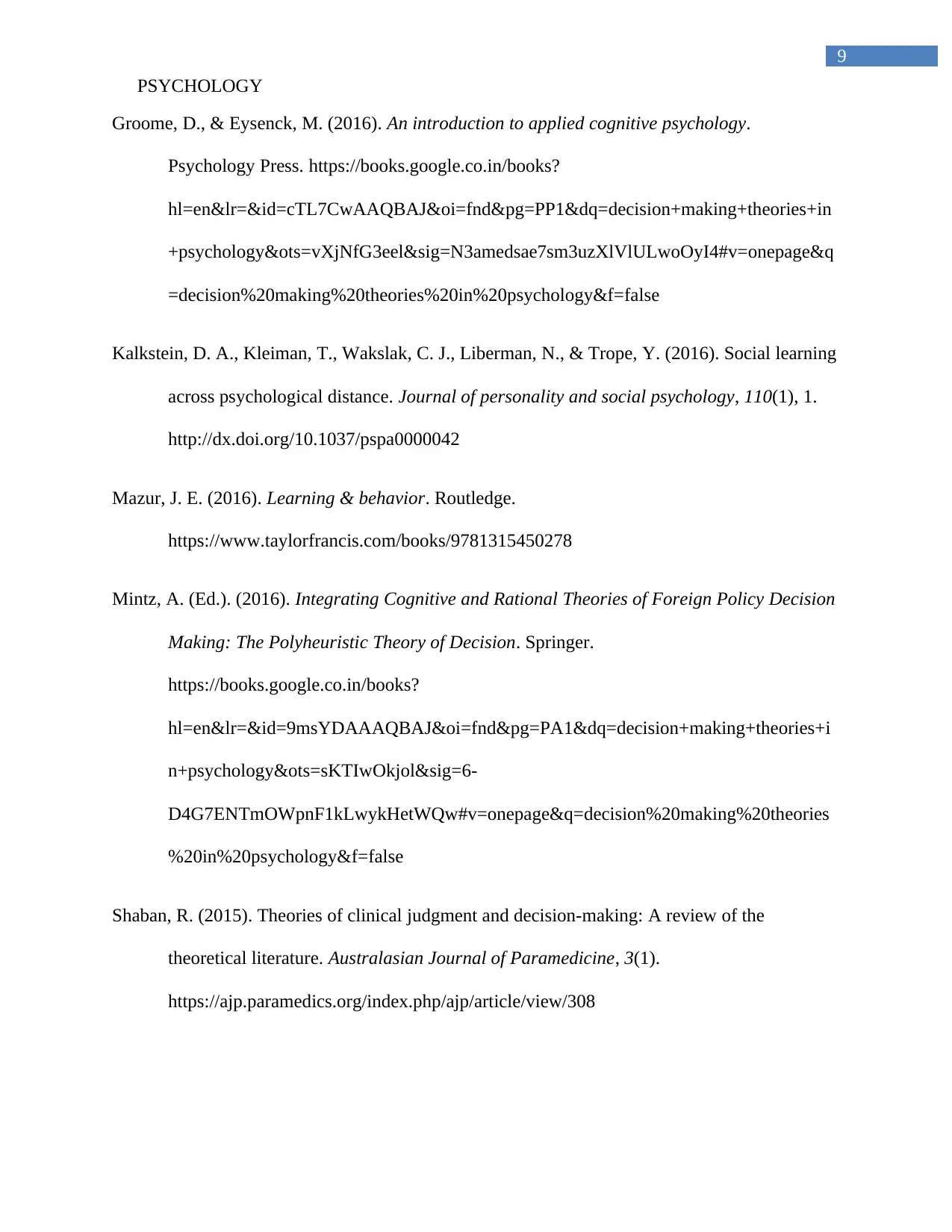
9
PSYCHOLOGY
Groome, D., & Eysenck, M. (2016). An introduction to applied cognitive psychology.
Psychology Press. https://books.google.co.in/books?
hl=en&lr=&id=cTL7CwAAQBAJ&oi=fnd&pg=PP1&dq=decision+making+theories+in
+psychology&ots=vXjNfG3eel&sig=N3amedsae7sm3uzXlVlULwoOyI4#v=onepage&q
=decision%20making%20theories%20in%20psychology&f=false
Kalkstein, D. A., Kleiman, T., Wakslak, C. J., Liberman, N., & Trope, Y. (2016). Social learning
across psychological distance. Journal of personality and social psychology, 110(1), 1.
http://dx.doi.org/10.1037/pspa0000042
Mazur, J. E. (2016). Learning & behavior. Routledge.
https://www.taylorfrancis.com/books/9781315450278
Mintz, A. (Ed.). (2016). Integrating Cognitive and Rational Theories of Foreign Policy Decision
Making: The Polyheuristic Theory of Decision. Springer.
https://books.google.co.in/books?
hl=en&lr=&id=9msYDAAAQBAJ&oi=fnd&pg=PA1&dq=decision+making+theories+i
n+psychology&ots=sKTIwOkjol&sig=6-
D4G7ENTmOWpnF1kLwykHetWQw#v=onepage&q=decision%20making%20theories
%20in%20psychology&f=false
Shaban, R. (2015). Theories of clinical judgment and decision-making: A review of the
theoretical literature. Australasian Journal of Paramedicine, 3(1).
https://ajp.paramedics.org/index.php/ajp/article/view/308
PSYCHOLOGY
Groome, D., & Eysenck, M. (2016). An introduction to applied cognitive psychology.
Psychology Press. https://books.google.co.in/books?
hl=en&lr=&id=cTL7CwAAQBAJ&oi=fnd&pg=PP1&dq=decision+making+theories+in
+psychology&ots=vXjNfG3eel&sig=N3amedsae7sm3uzXlVlULwoOyI4#v=onepage&q
=decision%20making%20theories%20in%20psychology&f=false
Kalkstein, D. A., Kleiman, T., Wakslak, C. J., Liberman, N., & Trope, Y. (2016). Social learning
across psychological distance. Journal of personality and social psychology, 110(1), 1.
http://dx.doi.org/10.1037/pspa0000042
Mazur, J. E. (2016). Learning & behavior. Routledge.
https://www.taylorfrancis.com/books/9781315450278
Mintz, A. (Ed.). (2016). Integrating Cognitive and Rational Theories of Foreign Policy Decision
Making: The Polyheuristic Theory of Decision. Springer.
https://books.google.co.in/books?
hl=en&lr=&id=9msYDAAAQBAJ&oi=fnd&pg=PA1&dq=decision+making+theories+i
n+psychology&ots=sKTIwOkjol&sig=6-
D4G7ENTmOWpnF1kLwykHetWQw#v=onepage&q=decision%20making%20theories
%20in%20psychology&f=false
Shaban, R. (2015). Theories of clinical judgment and decision-making: A review of the
theoretical literature. Australasian Journal of Paramedicine, 3(1).
https://ajp.paramedics.org/index.php/ajp/article/view/308
Secure Best Marks with AI Grader
Need help grading? Try our AI Grader for instant feedback on your assignments.
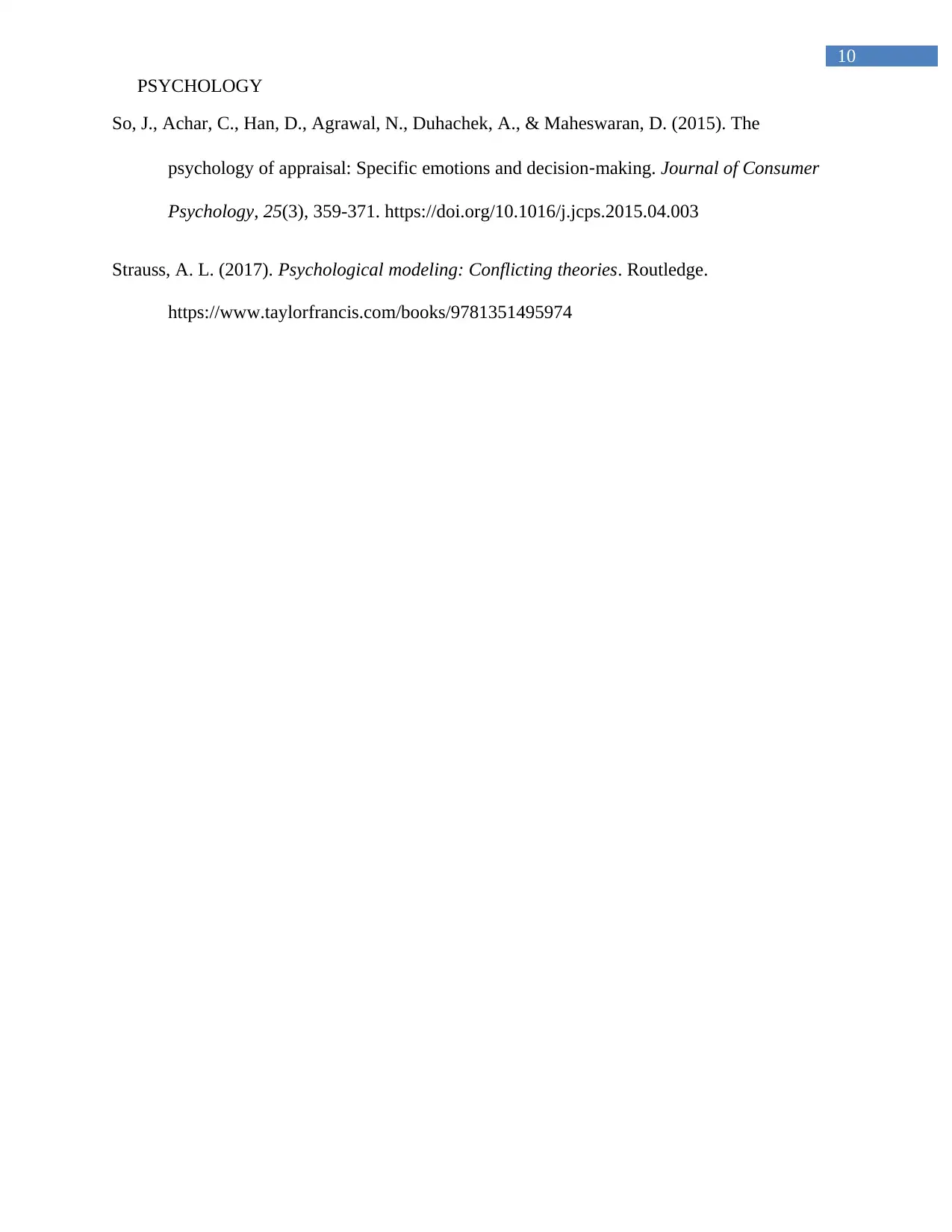
10
PSYCHOLOGY
So, J., Achar, C., Han, D., Agrawal, N., Duhachek, A., & Maheswaran, D. (2015). The
psychology of appraisal: Specific emotions and decision‐making. Journal of Consumer
Psychology, 25(3), 359-371. https://doi.org/10.1016/j.jcps.2015.04.003
Strauss, A. L. (2017). Psychological modeling: Conflicting theories. Routledge.
https://www.taylorfrancis.com/books/9781351495974
PSYCHOLOGY
So, J., Achar, C., Han, D., Agrawal, N., Duhachek, A., & Maheswaran, D. (2015). The
psychology of appraisal: Specific emotions and decision‐making. Journal of Consumer
Psychology, 25(3), 359-371. https://doi.org/10.1016/j.jcps.2015.04.003
Strauss, A. L. (2017). Psychological modeling: Conflicting theories. Routledge.
https://www.taylorfrancis.com/books/9781351495974
1 out of 11
Related Documents
Your All-in-One AI-Powered Toolkit for Academic Success.
+13062052269
info@desklib.com
Available 24*7 on WhatsApp / Email
![[object Object]](/_next/static/media/star-bottom.7253800d.svg)
Unlock your academic potential
© 2024 | Zucol Services PVT LTD | All rights reserved.





